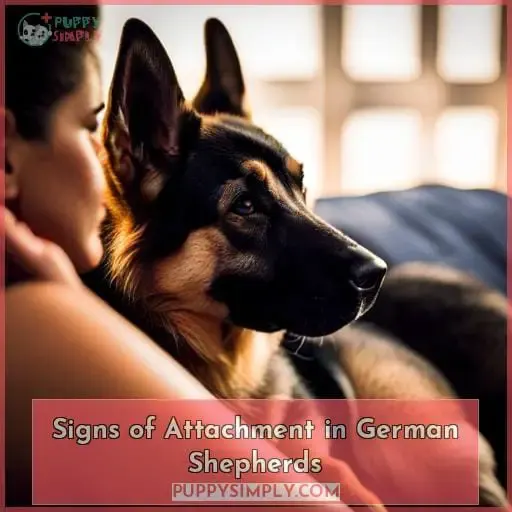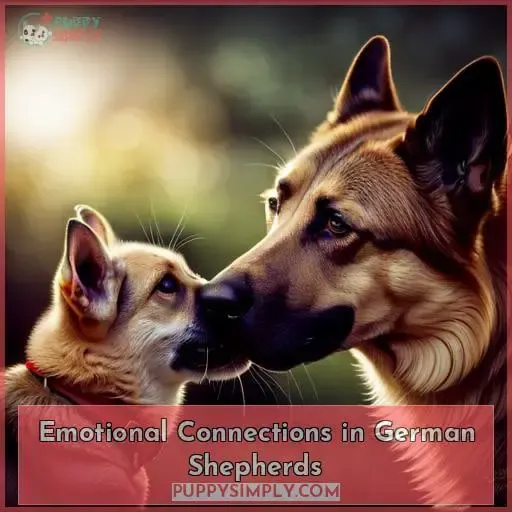This site is supported by our readers. We may earn a commission, at no cost to you, if you purchase through links.
 Curious about the mysterious bond between German Shepherds and their humans? Well, hold onto your leashes because we’re about to unveil the truth!
Curious about the mysterious bond between German Shepherds and their humans? Well, hold onto your leashes because we’re about to unveil the truth!
Do German Shepherds really bond with just one person or can they form strong connections with multiple family members?
In this eye-opening article, we’ll dive deep into the science behind these loyal companions.
Get ready to discover why these intelligent dogs may choose a favorite person and how you can strengthen that special connection.
Time to unleash some knowledge!
Table Of Contents
- Key Takeaways
- The Bonding Dynamics of German Shepherds
- Signs of Attachment in German Shepherds
- Factors Influencing Attachment
- Change and Flexibility in Bonding
- Building a Strong Bond With Your German Shepherd
- German Shepherds and Their Bond With Children
- Male Vs. Female German Shepherds: Bonding Differences
- Emotional Connections in German Shepherds
- Frequently Asked Questions (FAQs)
- Can German Shepherds form strong bonds with multiple people?
- How do German Shepherds show affection towards their owners?
- Do male German Shepherds bond differently than female German Shepherds?
- Can German Shepherds form emotional connections with their owners?
- What are some common misconceptions about German Shepherd bonding?
- Conclusion
Key Takeaways
- German Shepherds can form strong bonds with multiple people, not just one.
- Bonding is influenced by consistent care, trust, and positive reinforcement.
- Shared activities and experiences play a significant role in bonding with German Shepherds.
- Bonding relies on understanding each dog’s unique personality and needs.
The Bonding Dynamics of German Shepherds
When it comes to the bonding dynamics of German Shepherds, recognition based on consistent care plays a significant role.
These dogs form attachments rooted in trust and stability, seeking affectionate connections beyond just their primary caregiver. It reflects their need for structure and social bonds, creating a harmonious environment that contributes to a strong bond with those who provide consistent care and attention.
Recognition Based on Consistent Care
To understand the bonding dynamics of German Shepherds, it’s essential to recognize that their attachment is based on consistent care.
- Trust Development: Building trust through regular interaction and positive experiences.
- Behavioral Consistency: Providing a stable environment with predictable routines and expectations.
- Responsive Interaction: Being attentive and responsive to the dog’s needs for emotional connection.
- Routine Reinforcement: Reinforcing desired behaviors consistently over time for reinforcement of the bond.
Building a strong bond with your German Shepherd requires recognizing their need for consistency in care, as this forms the foundation of their attachment towards you as their primary caregiver.
- Trust Development:
Developing trust involves creating an environment where your German Shepherd feels safe and secure in your presence, allowing them to let down their guard and form a deep emotional connection.
- Behavioral Consistency:
Consistency in daily routines helps establish predictability which promotes feelings of security within them. By maintaining regular feeding times, exercise schedules, training sessions, grooming rituals etc.
- Responsive Interaction:
German Shepherds thrive when they receive attention from someone who not only meets their physical needs but also responds positively to cues or signals they exhibit when seeking companionship or communication (e.
- Routine Reinforcement
Regularly reinforcing desired behaviors through rewards such as treats and praise strengthens the association between those actions and positive outcomes like affectionate interactions and playtime together! This type of routine reinforcement solidifies understanding of boundaries and expectations while also showing appreciation and love towards each other, fostering unbreakable connections built on mutual respect and admiration!
Sustained Engagement
Lastly, sustained engagement signifies depth, commitment, investment, and nurturing, which leads to a long-lasting and successful bonding experience.
Attachment Rooted in Trust and Stability
Building a strong bond with your German Shepherd requires consistent care, as attachment is deeply rooted in trust and stability.
Understanding canine trust and nurturing stable bonds are crucial in developing a deep connection.
Through consistent training and building techniques, you can establish stable relationships based on trust.
This bond will result in loyalty, affection, and the recognition of you as their favorite person.
By providing stability through consistency, your German Shepherd will feel secure and develop an unbreakable bond with you.
Affectionate Connections Beyond Primary Caregiver
Developing a strong bond with your German Shepherd goes beyond the primary caregiver, as these loyal and affectionate dogs form deep connections with multiple individuals.
They’ve an emotional reach that extends to other family members, choosing their person based on shared experiences and interactions.
German Shepherds are capable of forming multiple bonds within the household, displaying affectionate behavior towards everyone who provides love and care.
Their broader connections enhance their social attachment and create a sense of belonging in the family unit.
- Canine Bonds
- Social Attachment
- Emotional Reach
- Multi-person Affection
- Broader Connections
Reflects the Need for Structure and Social Bonds
You need to provide the content for the subtopic Reflects the Need for Structure and Social Bonds (The Bonding Dynamics of German Shepherds).
- Behavioral Stability
- Socialization Impact
- Environmental Harmony
- Consistency Dynamics
- Structural Influence
German Shepherds bond strongly with one person, but it’s important to note that their bonding dynamics reflect a need for structure and social bonds in general. These dogs thrive in environments that provide behavioral stability, where they can be properly socialized and experience harmony within their surroundings.
In terms of bonding dynamics, consistency plays a crucial role as German Shepherds rely on predictable routines and interactions with their caregivers or family members. This consistency helps them feel secure in forming strong relationships based on trust.
The structural influence also affects how German Shepherds bond with others, whether it’s through regular training sessions or engaging activities like exercise or playtime together.
Overall, understanding the needs of German Shepherds when it comes to structure and social bonds is essential for fostering healthy relationships between these intelligent dogs and their human companions.
Creating a Harmonious Environment for the Breed
To create a harmonious environment for German Shepherds, it’s important to establish trust and stability through consistent care.
- Behavioral influences:
- Understanding the social structure of German Shepherds and their protective behavior can help in building a solid foundation for trust.
- Environmental impact:
- Providing a stable and secure environment that meets their physical, mental, and emotional needs contributes to their overall well-being.
- Socialization techniques:
- Properly introducing them to various people, animals, sounds, and environments from an early age helps develop positive associations and strengthens their ability to bond with different individuals.
By focusing on these aspects of care, you can ensure a harmonious relationship with your German Shepherd based on mutual understanding,
trust,and love
Signs of Attachment in German Shepherds
So, you might be wondering how to tell if your German Shepherd is attached to you.
One of the most prominent signs is constant eye contact, which shows trust and connection.
Additionally, they’ll often follow you around as a display of loyalty and lean against you for comfort and reassurance.
You’ll also notice their excitement when you arrive home and their selective obedience to your commands further demonstrates their attachment to you.
Constant Eye Contact as a Sign of Trust
In the bonding dynamics of German Shepherds, constant eye contact serves as a clear sign of trust and attachment. It’s one of the many ways these dogs communicate their feelings and form strong bonds with their owners.
Here are five discussion ideas about constant eye contact as a sign of trust:
- Canine communication: Eye contact is an essential part of how dogs convey messages to humans.
- Trust indicators: Constant eye contact indicates that your German Shepherd feels safe and comfortable in your presence.
Following Around Reflects Loyalty
One clear sign of attachment and loyalty in German Shepherds is their tendency to follow you around.
According to pet psychology, this act stems from their innate need for social interaction and trust dynamics. By staying close by your side, they demonstrate a strong bond and devotion towards you as their trusted companion.
Understanding this canine loyalty helps foster a stronger relationship while addressing any potential behavior issues or territorial behaviors that may arise.
Leaning Against for Comfort and Trust
When a German Shepherd leans against you, it’s a clear sign of comfort and trust in their attachment to you.
Leaning behavior in dogs is often seen as an expression of seeking comfort and showing affection.
For German Shepherds, this gesture signifies their confidence in your presence and the emotional support they receive from you.
It strengthens the bond between canine companions by reinforcing feelings of safety, security, and mutual understanding.
Excitement Upon Owner’s Arrival
As your German Shepherd eagerly jumps and wags its tail upon your arrival, it demonstrates the excitement that accompanies their strong attachment to you.
The joy they express when seeing you shows their deep connection and affection for you as their owner.
It’s heartwarming to witness this level of devotion in our pets, reaffirming the special family bond we share with them.
Selective Obedience to Commands
As your German Shepherd forms a strong bond with you, they’ll exhibit signs of attachment through selective obedience to commands. This behavior indicates their trust and loyalty towards you as their primary caregiver.
Through training techniques such as positive reinforcement and effective communication methods, you can strengthen this bond even further.
However, it’s important to be aware of the potential challenges that may arise during obedience training due to the breed’s high intelligence and independent nature.
Factors Influencing Attachment
When it comes to the factors that influence attachment in German Shepherds, several key elements play a role.
Trust, leadership, consistency, and affection are crucial for building a strong bond with your dog.
Recognition of positive reinforcement and engaging in shared activities further strengthen the attachment between you and your German Shepherd.
Understanding their individual needs and personality traits is also essential for fostering a deep connection based on trust during their critical socialization period.
Trust, Leadership, Consistency, and Affection
Through demonstrating trust, consistent leadership, and genuine affection, you’ll influence your German Shepherd’s attachment.
Build trust through structured exercises focused on obedience, confidence, and respect.
Adopt an authoritative leadership style balanced by compassion.
Maintain consistency in training using positive reinforcement.
Express affection through activities, praise, touch, and quality time together.
Meeting your dog’s needs with care and attention facilitates a harmonious bonding dynamic rooted in trust.
Recognition of Positive Reinforcement
To build a strong bond with your German Shepherd, it’s essential to recognize the positive reinforcement that influences their attachment.
Here are five discussion ideas regarding the recognition of positive reinforcement in German Shepherds:
- Reward-based training
- Incentive understanding
- Positive association
- Reinforcement recognition
By incorporating these concepts into obedience training and daily interactions with your dog, you can create a foundation of trust and companionship that strengthens your bond.
Engagement in Shared Activities
Do German Shepherds Bond With One Person?
Strengthen your bond by engaging in shared activities like training, exercising, and playing with your German Shepherd.
Participating in these activities together benefits both you and your dog. It promotes bonding dynamics, fosters collaboration, and creates a sense of inclusivity within the family.
Joint participation in play and exercise not only strengthens the connection between you and your German Shepherd but also enhances overall well-being for both parties involved.
Understanding the Dog’s Needs and Personality
Understanding the dog’s needs and personality is crucial in determining the factors that influence attachment in German Shepherds.
To develop an affectionate relationship, it’s essential to consider their individual needs, interaction dynamics, and temperament understanding.
Behavioral adaptation is influenced by socialization impact and environmental influences on these intelligent dogs.
Customized care based on personal preferences helps address emotional quirks while ensuring genetic health concerns are taken into account.
Calm and assertive leadership further enhances bonding dynamics with German Shepherds.
Trust Built During the Critical Socialization Period
During the critical socialization period, your German Shepherd develops trust and forms attachments influenced by various factors. This period, typically between 3 to 14 weeks of age, is crucial for their emotional development.
Social interaction with humans and other animals plays a significant role in establishing trust and shaping their behavior. Positive experiences during this time lay the foundation for early bonding with their caregivers.
Training methods that focus on positive reinforcement further strengthen this bond as they associate you with rewards and security.
Keep in mind that while initial bonds are formed during this critical period, it’s still possible to build new relationships or change favorites later in life through consistent care and training efforts.
Change and Flexibility in Bonding
When it comes to bonding dynamics, German Shepherds exhibit a certain level of change and flexibility.
- Changes in interaction patterns
- Shifts in the environment
Dogs live in the moment and react to their current circumstances, which can impact their attachment. Affection plays a crucial role in reflecting trust, comfort, and empathy within the bond.
As owners, responding effectively to these factors is important for maintaining a strong connection with your German Shepherd.
Shifts Influenced by Changes in Interaction
When interacting with German Shepherds, your shifts in behavior and engagement can greatly influence the flexibility and adaptability of their bonding dynamics.
Understanding the interaction dynamics is crucial for building strong connections.
By spending quality time together, creating a safe environment, and practicing effective communication, you can shape their behavioral adaptation to different situations.
Responding appropriately to evolving connections ensures that response variations are met with understanding and empathy while navigating potential challenges like sibling rivalry or gender differences.
Behavioral Adaptation, Interaction Dynamics, Adaptability Insights,
Evolving Connections
Impact of Environment and Health Changes
As your German Shepherd interacts with their environment and experiences changes in health, their bonding dynamics may adapt and shift accordingly.
Behavioral adaptation is a key aspect of this process, as dogs are highly adaptable creatures. Environmental shifts can influence the way they bond with you and others around them. Additionally, health influences play a role in their emotional resilience and ability to form strong bonds.
Nurturing them during these times of change is crucial for maintaining a strong bond built on trust, understanding, obedience, and affection.
Dogs Live in the Moment and React to Current Circumstances
However, German Shepherds live fully in the present moment and respond to circumstances as they currently stand between themselves and their owner(s).
You’ll notice shifts in their bonding as life changes unfold around them.
As highly perceptive dogs, they react in real-time to momentary interactions, with their responsive nature allowing them to readily adapt their bonding style to match current relationships and needs.
Their circumstantial bonding reflects an attunement to present reactions and immediate responses from those they interact with.
Affection Reflects Trust, Comfort, and Empathy
In light of their living in the moment, your German Shepherd shows affection depending on the trust, comfort, and empathy you demonstrate toward them. Affectionate responses from your loyal companion reflect the strong emotional attachment they’ve formed with you.
Trust dynamics play a crucial role in building comfortable bonds between humans and German Shepherds. By providing consistent care, understanding their needs through canine education, and fostering empathetic connections, you can strengthen your bond and create a secure foundation for a lifelong relationship filled with love and loyalty.
Responding to Factors to Maintain a Strong Bond
You’ll need to stay aware of your German Shepherd’s needs and respond appropriately to maintain your bond as circumstances change.
Understanding canine behavior is crucial for adapting to changes and strengthening trust.
To retain the emotional connection, reinforce positive interaction by:
- Spending quality time together
- Engaging in activities that your German Shepherd enjoys
- Providing consistent training assistance.
By doing so, you can improve the relationship with your loyal companion while navigating through life’s ups and downs.
Building a Strong Bond With Your German Shepherd
To build a strong bond with your German Shepherd, it’s crucial to understand their breed-specific needs.
This includes:
- Providing them with consistent and positive training methods that reinforce good behavior.
- Engaging in regular play and exercise routines that will help keep them mentally stimulated and physically active.
- Demonstrating affection and attention through gentle touch, praise, and quality time together that will strengthen the emotional connection between you both.
- Using effective communication techniques such as clear commands, body language cues, and establishing yourself as a confident leader that will establish trust and respect in your relationship with your German Shepherd.
Understanding Breed-specific Needs
To build a strong bond with your German Shepherd, it’s essential to understand their breed-specific needs.
- Proper behavioral training
- Social interaction
- Mental stimulation
Creating an adaptive environment that offers healthy exercise and playful engagement will also contribute to a stronger bond. Additionally, effective communication methods and leadership skills are crucial for building trust and maintaining a positive relationship with your German Shepherd.
| Breed-specific Needs | Examples |
|---|---|
| Behavioral Training | Agility work |
| Owners’ Responsibilities | Scent detection |
| Social Interaction | Establishing feeding routine |
Consistent and Positive Training
By consistently providing positive training for your German Shepherd, you can further strengthen the bond between you and your furry companion.
Use reward-based methods and clear communication to reinforce desired behaviors.
Maintain consistency in your commands, tone, and reactions to encourage obedience development. This establishes you as a trusted leader while meeting the breed’s needs for mental stimulation.
An emphasis on positive interactions will deepen your bond.
Engaging in Play and Exercise Routines
But you need to also engage in play and exercise routines with your German Shepherd, as this helps strengthen the bond by reinforcing trust and loyalty through shared activities.
- Take your dog on daily walks and hikes
- Engage in games like fetching balls or frisbees
- Sign up for agility, nosework or obedience classes
Demonstrating Affection and Attention
When you’re demonstrating affection and attention towards your German Shepherd, it nurtures the emotional bond through ongoing positive engagement with the dog.
By consistently providing attention, you express an emotional connection that reinforces affection bonds. This can be achieved through various ways such as petting, praising, and spending quality time together.
Training through affection is also essential in building a strong bond with your German Shepherd. Understanding their needs and showing consistent attention will help foster a deep connection between you and your furry companion.
Building a strong bond with your German Shepherd requires more than just physical care; it involves expressing love and devotion to create lasting connections.
When interacting with them, make sure to demonstrate consistent attention by engaging in activities they enjoy like playing fetch or going for walks together. Expressing this type of genuine interest helps reinforce the emotional connection between both of you while meeting their need for companionship.
Effective Communication and Leadership
How can you effectively communicate and demonstrate leadership to build a strong bond with your German Shepherd?
It’s crucial to establish clear communication styles and utilize effective leadership techniques.
Consistency in training, using positive reinforcement, will foster trust and understanding.
Incorporating bonding rituals such as regular exercise routines, playtime, and grooming sessions will strengthen the connection between you and your dog.
Understanding your German Shepherd’s needs on a canine level is essential for building a solid foundation of effective communication and leadership that enhances the bond between you both.
German Shepherds and Their Bond With Children
When it comes to German Shepherds and their bond with children, there’s potential for strong connections. However, it requires supervision, training, and understanding from both the adults and the children involved.
It’s important to teach children to respect the dog’s space and signals while also training the dogs to behave gently around kids.
Through this mutual enrichment of loyalty, protection, and playfulness, German Shepherds can form lasting bonds with children in a safe environment.
Forming Strong Bonds With Children
To form strong bonds with children, German Shepherds require supervision, training, and understanding.
It’s important to teach children to respect the dog’s space and signals while ensuring that the dogs are trained to behave gently around kids.
Through playful interactions and mutual enrichment, German Shepherds can form lasting bonds with children.
Their protective nature combined with their ability to listen to commands makes them excellent companions for kids when proper supervision dynamics are in place.
Supervision, Training, and Understanding Required
As their owner, you’ll need to:
- Properly supervise interactions
- Train your German Shepherd
- Understand their signals
When bonding them with your kids:
- Always ensure supervised playtime between the dog and child to prevent any potential harm.
- Utilize effective training techniques that promote positive behavior around children.
- Understand canine communication cues to gauge the dog’s comfort level during interactions with your child.
- Establish bonding rituals such as sleeping near each other or participating in shared activities that strengthen their connection over time.
Teaching Children to Respect the Dog’s Space and Signals
To ensure a harmonious bond between German Shepherds and children, it’s essential to teach the young ones in your household to respect the dog’s space and signals.
Canine etiquette should be taught through kid-friendly training sessions that emphasize boundaries and respectful interaction.
Children need to understand how to approach, pet, and play with their furry companions in a safe manner.
This knowledge will foster a positive relationship built on trust between German Shepherds and children.
Training Dogs to Behave Gently Around Kids
Although teaching children to respect a German Shepherd’s space is important, you’ll also need to train your German Shepherd to behave gently around kids since mutual understanding is key for safe interactions.
- Teach child-friendly commands like sit or stay that help establish boundaries.
- Use positive reinforcement techniques to reward calm and gentle behavior.
- Supervise all interactions between your dog and kids, providing guidance when necessary for a kid-safe training environment.
Mutual Enrichment Through Loyalty, Protection, and Playfulness
German Shepherds enhance the lives of children through their loyalty, protection, and playful nature. They form bonds with kids through playful interactions, which allow them to express their protective instincts and loyalty.
| Bonding Activity | Child Benefit |
|---|---|
| Playful Interactions | Emotional Enrichment |
| Demonstrations of Loyalty | Security, Confidence |
| Protective Instincts | Safety, Trust |
| Shared Activities | Companionship, Responsibility |
Male Vs. Female German Shepherds: Bonding Differences
When it comes to bonding differences between male and female German Shepherds, there are some general tendencies that can be observed.
- Males may exhibit more protective and assertive behaviors.
- Females tend to be gentler and nurturing.
However, it’s important to note that individual temperament varies greatly regardless of gender.
Ultimately, the formation of a bond with a German Shepherd depends more on the care and attention provided by their owner rather than their gender.
Males Might Be More Protective and Assertive
Are male German Shepherds more protective and assertive than their female counterparts?
While individual temperament can vary, males tend to exhibit stronger protective instincts. This is due to their natural inclination towards guarding and territorial behavior.
However, it’s important to note that gendered traits alone don’t determine bonding differences. Factors such as breeding, upbringing, and training also play significant roles in shaping a dog’s behavior.
Consistent training approaches and proper socialization impact the behavioral consistency of both male and female German Shepherds.
Females Might Be Gentler and Nurturing
You’ll find that female German Shepherds tend to exhibit a gentler and nurturing nature compared to their male counterparts. These traits contribute to the formation of a gentle bonding and nurturing connection between female German Shepherds and their owners.
While individual temperament can vary, gender tends to influence affectionate behavior in these dogs. Understanding these gendered affection dynamics can help owners develop stronger bonds with their female German Shepherds based on mutual care, trust, and nurturance.
Individual Temperament Varies Despite Gender Tendencies
When it comes to bonding with their human companions, German Shepherds exhibit individual temperament variations that can differ despite gender tendencies.
Contrary to popular gender myths, there’s no significant evidence supporting the idea that male or female German Shepherds have inherently different bonding capabilities.
The behavior and temperament of a German Shepherd are influenced by various factors such as breeding, upbringing, and training approaches rather than solely relying on their gender.
It’s important to focus on the unique needs and personality traits of each dog when building a strong bond regardless of their sex.
Behavior Influenced by Breeding, Upbringing, and Training
While individual temperament varies, a German Shepherd’s behavior is largely influenced by their breeding, upbringing, and training.
You’d see both similarities and differences in bonding between males and females that depend more on how the dog was raised rather than its gender.
A German Shepherd’s temperament and bonding ability stems from genetics and early socialization, with dedicated training molding key behaviors.
Despite tendencies, individual variance in bonding remains, with nurture holding more sway than nature regarding a German Shepherd’s relationships.
Bond Formation Depends More on Care and Attention Than Gender
You’re discovering that when it comes to bonding, male and female German Shepherds don’t differ as much as you’d think – it’s the time and care you devote that makes the real difference.
Despite myths, their capacity for affectionate bonds depends not on gender, but on the patient nurturing all individual dogs need.
With appropriate attention, any German Shepherd can become a loyal companion.
Emotional Connections in German Shepherds
When it comes to emotional connections, German Shepherds are known for their loyalty and affection. They can form strong bonds with their owners and show signs of distress when separated from them.
Signs of affection include:
- Tail wagging
- Leaning against their owner
- Following them around
- Engaging in gentle play
While there’s no scientific evidence to suggest that male German Shepherds prefer female owners over male ones, they’re trainable to listen to multiple people but may have a primary bond with one individual.
Dogs Can Miss Their Owners, Showing Signs of Distress
One clear indication of the emotional connection German Shepherds form with their owners is when they display signs of distress upon being separated. It’s a heart-wrenching sight to witness your loyal companion experiencing canine distress and loneliness.
These emotional signals can tug at your heartstrings, evoking feelings of empathy and a deep desire to comfort them. The bond between you and your German Shepherd becomes evident as you observe these bonding behaviors in moments of owner separation.
- Pleading eyes filled with sadness
- Whining or whimpering sounds that express longing
- Restlessness and pacing, searching for their beloved owner
Preference for Companionship and Interaction
When it comes to emotional connections, German Shepherds prefer companionship and interaction with their owners.
These intelligent and loyal dogs thrive on the social bond they form with their human family members.
They show affection through interactive behaviors such as tail wagging, leaning against their owners, following them around, and engaging in gentle play.
This preference for canine companionship highlights the importance of familial attachment in building a strong bond between German Shepherds and their human counterparts.
Signs of Affection: Tail Wagging, Leaning, Following, Gentle Play
As your German Shepherd forms emotional connections, you may notice signs of affection such as:
- Tail wagging
- Leaning against you for comfort and trust
- Following you around with loyalty
- Engaging in gentle play.
These behaviors serve as bonding cues and trust signals in canine communication.
Tail wagging indicates happiness and excitement while leaning signifies a desire for physical contact.
Following demonstrates loyalty and the desire to be close to their trusted person.
Gentle play reinforces the emotional connection between you and your German Shepherd, fostering social dynamics based on trust and affection.
No Evidence of Male German Shepherds Preferring Female Owners
Male German Shepherds don’t exhibit a preference for female owners, as their emotional connections are formed based on shared activities and individual bonding experiences.
- No scientific evidence supports gender preferences in dogs.
- Bonding occurs through training, play, exercise.
- Breeding and socialization influence behavior more.
- Emotional bonds depend on care, not owner gender.
Trainable to Listen to Multiple People, Form a Primary Bond With One
You can train German Shepherds to listen to multiple people, but they often form a primary bond with one individual. This doesn’t mean they won’t respond or develop relationships with others in the household.
Canine communication plays an important role in multi-person engagement, allowing the dog to understand and interact with different family members.
Bonding myths suggesting that German Shepherds can only have one person are inaccurate; they’re capable of forming strong and meaningful connections with multiple individuals while still maintaining a primary bond with their chosen caregiver.
Frequently Asked Questions (FAQs)
Can German Shepherds form strong bonds with multiple people?
German Shepherds can form strong bonds with multiple people. Their ability to bond extends beyond one person and is influenced by:
- Shared activities
- Consistent care
- Trust
- Positive reinforcement
Building a strong bond involves engaging in:
- Training
- Exercise routines
- Demonstrating affection
How do German Shepherds show affection towards their owners?
When it comes to showing affection, German Shepherds have their own unique ways.
Picture this:
your loyal Shepherd leaning against you, tail wagging with joy as if saying
I trust and love you.
Do male German Shepherds bond differently than female German Shepherds?
There is no conclusive evidence that male and female German Shepherds form bonds differently.
Their individual temperaments, determined more by upbringing and training than gender, influence bonding capacity.
Building strong connections relies on understanding each dog’s unique personality and needs, not assumptions based on sex.
Can German Shepherds form emotional connections with their owners?
Yes, German Shepherds can absolutely form emotional connections with their owners.
As an intelligent and loyal breed, they bond deeply through shared experiences like training, exercise, and play.
This facilitates an affectionate relationship built on trust and companionship.
What are some common misconceptions about German Shepherd bonding?
Do German Shepherds bond with one person?
Contrary to popular belief, German Shepherds can form strong bonds with multiple individuals.
Shared activities, consistent training, and affectionate interactions are key in building a solid bond with these loyal companions.
Conclusion
To sum it up, German Shepherds are capable of forming strong connections with multiple family members, despite often having a favorite person.
[Keypoints]Signs of attachment include:
- Constant eye contact
- Following their owner around
- Leaning against them
- Showing excitement upon their arrival
Factors such as trust, leadership, consistency, and engagement in shared activities influence attachment.
While bonding dynamics can change, maintaining a strong bond involves:
- Understanding breed-specific needs
- Positive training
- Play and exercise
- Affection
- Effective communication














